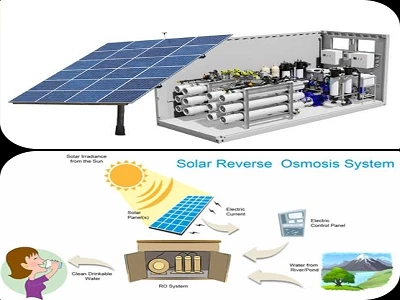In some countries there is no electricity in villages or towns, so we do water drinking plants based on solar plants. Some remote mining industries also don’t have electricity so we do turnkey projects for WTP based on solar panels. Solar energy to drive water treatment processes has become a potentially sustainable solution to the world’s water scarcity issue.
Desalination plant of seawater and brackish water has become a sustainable alternative solution to provide fresh water for many water-stressed regions. Solar energy can be used directly or indirectly to run desalination plants.
Our facility is outfitted with state-of-the-art machinery and cutting-edge technology to help us to provide superior selection of products as manufacturers of solar water treatment systems. And as exporters of Solar Operated Water Treatment Plants, we meet the demands of many clients and facilitate the efficient management of business-related operations. SOLAR OPERATED WATER TREATMENT PLANT
WORKING OF SOLAR OPERATED WATER TREATMENT PLANT
SOLAR RO PLANT (SOLAR REVERSE OSMOSIS SYSTEM):
As Solar operated drinking water system manufacturer, the Solar-powered Reverse Osmosis Plant is considered the most efficient, due to its low specific energy consumption (2~5 kWh /m3 ) while having the largest desalination installation capacities.
HOW SOLAR RO PLANT WORKS?
In Solar-powered Reverse Osmosis Plant or RO PLANT, seawater is fed to the membrane with high pressure to overcome the osmotic pressure of the feed water. Freshwater is collected at the permeate side while the concentrated brine is removed in the Solar Powered RO Plant. Feed pressure of solar powered RO systems conventionally ranges from 6~8 MPa for seawater applications and 0.6~3MPa for brackish water applications.
The productivity and recovery ratio of solar RO system is mainly affected by the properties of the used membrane, the salinity of feed water, feed pressure and feed flow rate, etc. The well-structured energy recovery devices in modern RO plants contributed significantly to the high energy efficiency of the process. Vast research has been conducted in terms of solar-driven RO desalination systems. When combined with solar energy, RO can be either run by electrical power that is generated by photovoltaic (PV) cells or solar thermal power plants, or by mechanical power that is produced from solar thermal energy by a thermodynamic cycle. Additionally, as suppliers of solar water treatment plants, our key priority have always been to fully understand client demands and offer the finest solutions to consistently and economically meet those needs.


